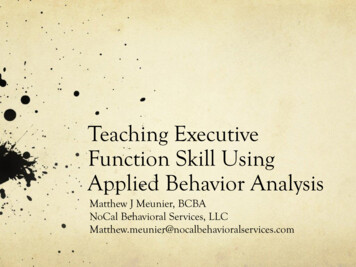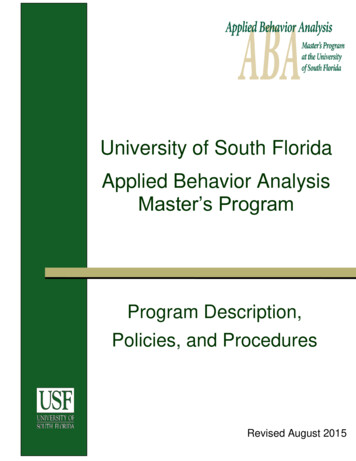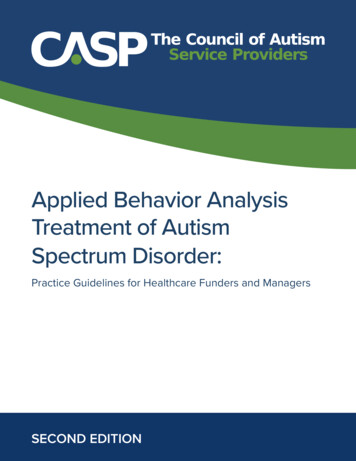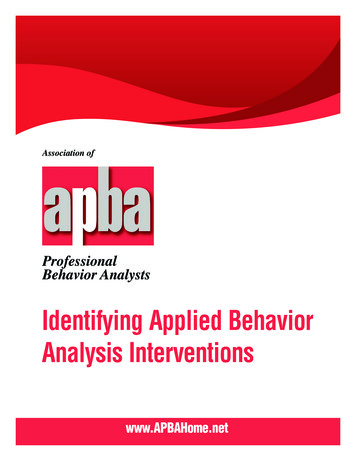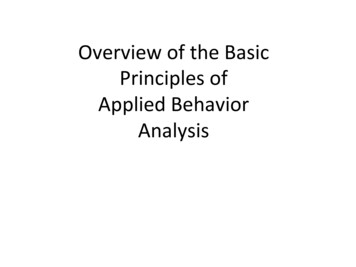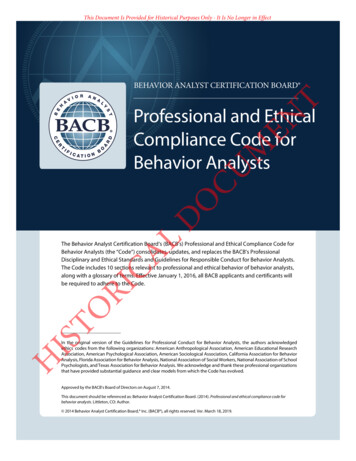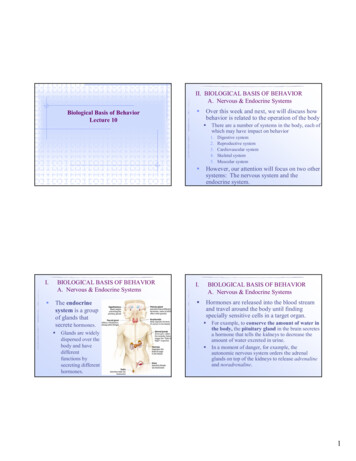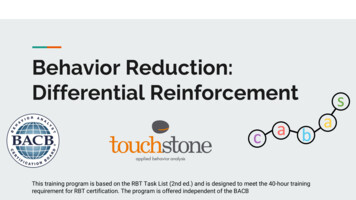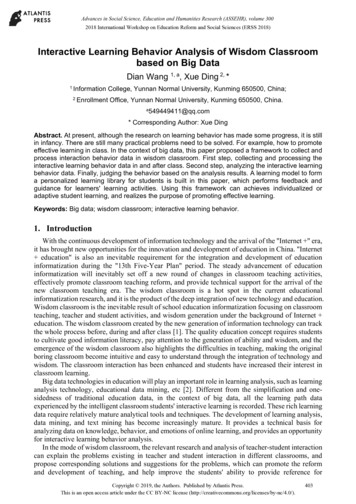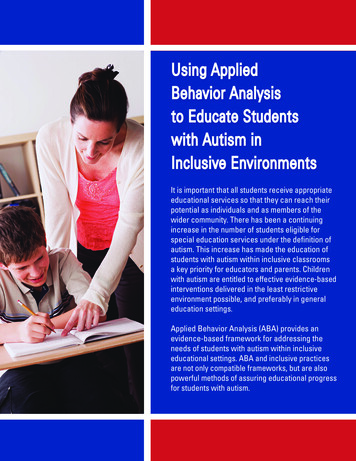
Transcription
Using AppliedBehavior Analysisto Educate Studentswith Autism inInclusive EnvironmentsIt is important that all students receive appropriateeducational services so that they can reach theirpotential as individuals and as members of thewider community. There has been a continuingincrease in the number of students eligible forspecial education services under the definition ofautism. This increase has made the education ofstudents with autism within inclusive classroomsa key priority for educators and parents. Childrenwith autism are entitled to effective evidence-basedinterventions delivered in the least restrictiveenvironment possible, and preferably in generaleducation settings.Applied Behavior Analysis (ABA) provides anevidence-based framework for addressing theneeds of students with autism within inclusiveeducational settings. ABA and inclusive practicesare not only compatible frameworks, but are alsopowerful methods of assuring educational progressfor students with autism.
AutismAutism is a disorder affecting a significantnumber of children within the Commonwealthof Pennsylvania and across our nation andthe world. Current estimates regarding theincidence of autism suggest that autismoccurs in about 1 in 68 children (CDC, 2015).As of December 2014, 29,273 Pennsylvaniastudents received special education servicesunder the eligibility definition of autism(PDE Child Count Data, 2015).The core characteristics of autism areimpairments in social interaction and communication and the presence of repetitiveor stereotyped patterns of behavior. Autismis considered a spectrum disorder in that itcan affect patterns of behavior and levels ofinvolvement to different degrees across individuals who have received the diagnosis. Allindividuals with autism can learn; however,skill levels for cognition, communication,social and motor skills may show considerable variation across individuals.Inclusive PracticesInherent in inclusive practices is the conceptof belonging or membership within the general education classroom. It differs from thepast practice of mainstreaming where a childneeded to demonstrate a readiness to beeducated in general education settings byobtaining a predetermined academic orbehavioral level of functioning. Inclusivepractices means that all students, regardlessof cognitive or academic level, are membersof the general education class, and thatappropriate supports are provided so thateach student can learn and participate.Inclusive education is about individualsbelonging to a community. Their communitymay include their school, the age-appropriategroup of children with whom they will interact,and the neighborhood in which they reside.According to a significant federal court ruling(Oberti v. Board of Education in ClementonSchool District, 1993), “Inclusion is a right, notthe privilege of a select few.” An inclusiveschool is a place where everyone belongs, is2accepted, and supports and is supported byher or his peers and other members of theschool community in the course of having hisor her educational needs met (Stainback &Stainback, 1990, p. 3).The Individuals with Disabilities Education Act(IDEA) supports inclusive practices by requiringthat “to the maximum extent appropriate,children with disabilities, including childrenin public or private institutions or other carefacilities, are educated with children that arenondisabled; and that special classes, separateschooling or other removal of children withdisabilities from the regular educational environment occurs only if the nature or severity issuch that education in regular classes with theuse of supplementary aids and services, cannotbe achieved satisfactorily” (IDEA, 1997).The least restrictive environment componentof IDEA establishes a preference for educatingstudents with disabilities in general educationclasses with supplementary aids and services(Burns, 2003; Etscheidt & Bartlett, 1999).Consideration of the general educationclassroom must be the starting place for anydecision making about the placement of a student who receives special education services.Adaptations and modifications to the generaleducation curriculum and activities are provided to ensure the student is receivinginstruction appropriate to his or her needs.The term “full inclusion” is used by some tomean the inclusion of every student with adisability in a general classroom, throughoutthe school day, without exception. Althoughit may be appropriate for some students toremain in general education all day, IDEArequires that a continuum of placementsvarying in their restrictiveness be available toensure that all needs are met. Pennsylvaniaschool districts maintain the required continuum of placements that are designed toprovide a rich supply of diverse programsthat support sound inclusive practices.
Although adherence to a high level ofacademic standards is imperative, inclusiveeducation asserts that “Whether students’needs have been met is reflected not onlyby whether they have attained certain objectives, but by the impact that educationalexperiences have had on their lives”(Giangreco, 1994). The quality of life of anindividual with a disability and his or heracceptance and participation in the community are as important as academic growth.Applied Behavior AnalysisApplied Behavior Analysis (ABA) is ascientific approach to behavior focused onenvironmental events that are crucial to itsunderstanding and change: antecedents andconsequences. Its principles are used tochange and improve behaviors. The effectiveness of these principles has been confirmedby many experimental studies and can beapplied in a variety of settings with differenttypes of people—infants to adults.In schools, ABA has been used to guide awide variety of successful educational practices in both general and special educationprograms. Over the past 20 or more years,ABA has been established as a powerfulsource of interventions in educational programs for students with autism. ABA hasconsistently been effective in assisting individuals with autism in achieving meaningfuland non-trivial progress (see NAC StandardsReport, 2009).By analyzing the relationship between theantecedent (what happened before thebehavior occurred), the behavior (what behavior actually occurred), and the consequence(what happened after the behavior occurred),educators or educational teams can begin todevelop a comprehensive plan for changingbehavior.Interventions derived from the field of ABAhave been demonstrated as being effective inassisting individuals with autism in acquiringskills that provide significant educational benefit (NAC, 2009). Interventions based on theprinciples of ABA have been developed(Hundert, 2009) to establish conditionsthat support individuals with autism as fullmembers of the schools they attend.The Link Between Autism, Inclusion, andABAHaving students simply placed in an environment because it is inclusive is not enough.“Being there” is necessary, but not sufficient.Students need to be included and receivemeaningful educational benefit. It is the individualized education program (IEP) planningteam, including parents of students withautism, that determines both services andleast restrictive educational programming.In Pennsylvania, Individualized EducationProgram (IEP) teams are required to adhereto the following guidelines when makingeducational placement decisions: A free and appropriate public education(FAPE) must be provided to every studentwith an IEP; moreover, FAPE must bedelivered in the least restrictive environment (LRE) as decided by the IEP team. Students will not be removed fromgeneral education classrooms merelybecause of the severity of theirdisabilities. When students with disabilities, including students with significant cognitivedisabilities, need specially-designedinstruction or other supplementary aidsand services to benefit from participating in general education classrooms, asrequired in their IEP, local educationagencies are obliged to ensure thatthose services are provided. IEP teams must determine whether thestudent’s IEP can be implemented ingeneral education classrooms with supplementary aids and services beforeconsidering removal from the generaleducation classroom.3
School districts will consider the fullrange of supplementary aids andservices in general education classrooms, based on peer-reviewedresearch to the extent practicable,including modification of curriculumcontent, before contemplating placement in a more restrictive setting.“Supplementary aidsand services meansaids, services, andother supports thatare provided in generaleducation classes,other educationrelated settings, andin extra-curricular andnonacademic settings,to enable childrenwith disabilities tobe educated withnondisabled childrento the maximum extentappropriate.”(PA Education Regulations,Chapter 14, 34 CFR 300.42)In educational settings, supplementaryaids and services must be available to allstudents who need them. Supplementaryaids and services are designed to providemeaningful educational benefit and are provided in a manner that avoids stigmatizingstudents (Gaskin Settlement Agreement,2005). Stigmatizing is calling attention todifferences in a way that lessens a person’svalue or esteem. Instruction for studentswith autism may target several areas that4will allow critical supports to be deliveredwithout stigmatizing effects (Hundert, 2009): Teaching the skill to participate andlearn in a group Teaching the skill to initiate andsustain reciprocal peer interactions Teaching the skill to completeseatwork assignments independently Teaching the skill to communicateneeds clearly and independently Teaching the skill to follow classroomroutines independently Reducing problem behaviors thatinterfere with learning Teaching the skill to self-regulate,make inferences, and take theperspective of othersThese areas are not prerequisites for participation in an inclusive setting for studentswith autism, rather they are areas in whichsupplemental aids and services are oftenbeneficial. Each of these areas has beenaddressed through behavior analyticprinciples.While the body of interventions derived fromthe field of ABA for inclusive educationalpractices is too large to be reviewed in detailhere, some key interventions are highlightedon the following page. Effective student outcomes and inclusive educational opportunitiesare selected from evidence-based approaches.The evidence of what works for students iscentral for planning purposes. ABA providesa powerful, evidence-based framework foraddressing the needs of students with autism.Decision making, however, should not beguided by any one approach, rather it shouldbe guided by the collaborative and databased discussions of the IEP team. ABA isone of several approaches that need to beconsidered in planning educational programs.
Often a class-wide approach can beeffective in promoting adjustment forstudents with autism. Class-wide interventions have been implemented thataddress many of the areas listed byHundert (2009). Communication skills for students withautism in general education settings canbe enhanced through teaching studentshow to make meaningful requests(Sundberg and Partington, 1998), howto ask for information when they are notsure (Ingvarsson, Hollobaugh, 2010),how to respond to questions (intraverbal training) and how to improveconversational skills (Davis, Boon,Cihak and Fore, 2010). Peer interactions have been facilitatedthrough interventions such as socialskill training, peer incidental teaching(McGee et al., 1992), recess buddies(Laushey and Heflin, 2000) and socialscripts (Goldstein and Cisar, 1992;McClannahan, 1998; Sarokoff, Taylorand Poulson, 2001). Social script interventions such as“power cards” can promote conversational skills acquisition (Davis, Boon,Cihak, and Fore, 2010).serve. Behavioral interventions fromboth applied behavior analysis and positive behavior supports have focused onteaching students alternative behaviorsthat are a more effective form of communication than engaging in problembehavior (Carr and Durand, 1985). Video modeling is an effective toolfor assisting students with autism indeveloping a wide range of social skills(Charlop–Christy and Daneshvar, 2003).In addition, behavior analysis has establishedeffective procedures for training communitiesin the awareness of individual abilities andthe acceptance of differences for all students,including those with autism.Inclusive practices are best facilitated whensupplementary aids and services are wellplanned, person centered, and evidencebased. The field of applied behavior analysisprovides a powerful source of interventiondesign, monitoring, and training to insurethat students with autism receive maximumbenefit from their educational experience in awide range of settings, including the generaleducation classroom. Picture activity schedules may promoteindependence for students with autism(Bryan and Gast, 2000; MacDuff, et al.1993; McClannahan and Krantz, 1999). Self-monitoring strategies have beenshown to be effective in assisting students in adjusting to a wide range ofissues that may arise in the generaleducation environment. Positive behavior supports (Horner,2000) have been derived from appliedbehavior analysis and suggest principles that can reduce problem behaviorsby making the behavior inefficient andineffective for whatever function it may5
ReferencesBaer, D.M., Wolf, M.M., & Risley, T.R. (1968). Some current dimensions of applied behavior analysis.Journal of Applied Behavior Analysis, 1, pp. 91-97.Behavior Analyst Certification Board. (2010). BCBA and BCaBA behavior analyst task list, Third Edition.Bryan, L.C., & Gast, D.L. (2000). Teaching on-task and on-schedule behaviors to high-functioningchildren with autism via picture activity schedules. Journal of Autism and DevelopmentalDisorders, 30, pp. 553-567.Burns, E. (2003). A handbook of supplementary aids and services. Springfield, Ill.: Charles C. Thomas.Carr, E.G., & Durand, V.M. (1985). Reducing problem behavior through functional communicationtraining. Journal of Applied Behavior Analysis, 25, pp. 777-794.Charlop-Christy, M.H., & Daneshvar, S. (2003). Using video modeling to teach perspective taking tochildren with autism. Journal of Positive Behavior Interventions, 5, pp. 12-21.Center for Disease Control and Prevention (2015). Autism and Developmental Disabilities Monitoring(ADDM) Network. http://www.cdc.gov/ncbddd/autism/addm.html.Davis, K.M., Boon, R.T., Cihak, D.F., & Fore III, C. (2010). Power cards to improve conversational skills inadolescents with Asperger syndrome. Focus on Autism and Other Developmental Disabilities, 25,pp. 12-22.Etscheidt, S., & Bartlett, L. (1999). The IDEA amendments: A four step approach for determining aidsand services. Exceptional Children, 65, pp. 163-174.Gaskin v. Pennsylvania, 389 F. Supp. 2d 628 (E.D. Pa. 2005).Giangreco, M.F. (1994). Effects of a consensus-building process on team decision-making: Preliminarydata. Physical Disabilities: Education and Related Services, 13 (1), pp. 41-56.Goldstein, H., & Cisar, C.L. (1992). Promoting interaction during social play: Teaching scripts to typicalpreschoolers and classmates with disabilities. Journal of Applied Behavior Analysis, 25,pp. 265-280.Horner, R.H. (2000). Positive behavior supports. Focus on Autism and Other Developmental Disabilities,15, pp. 97-105.Hundert, J. (2009). Inclusion of students with autism: Using ABA-based supports in general education.Austin Texas: Pro-ed.Individuals with Disabilities Education Act of 2004, 20 U.S.C. §1412 (a)(5).Individuals with Disabilities Education Act. (2006). IDEA Regulations 34 C.F.R. § 300.114(a).6
Ingvarsson, E.T., & Hollobaugh, T. (2010). Acquisition of intraverbal behavior: Teaching children withautism to mand for answers to questions. Journal of Applied Behavior Analysis, 43, pp. 1-17.Krantz, P.J., & McClannahan, L.E. (1998). Social interaction skills for children with autism: A script fading procedure for beginning readers. Journal of Applied Behavior Analysis, 31, pp. 191-202.Laushey, K.M., & Heflin, L.J. (2000). Enhancing social skills of kindergarten children with autismthrough the training of multiple peers as tutors. Journal of Autism and Developmental Disorders,30, pp. 183-193.MacDuff, G.S., Kranz, P.J., & McClannahan, L.E. (1993). Teaching children with autism to use photographic activity schedule: Maintenance and generalization of complex response chains. Journalof Applied Behavior Analysis, 26, pp. 89-97.McClannahan, L.E., & Krantz, P.J. (1999). Activity schedules for children with autism: Teaching independent behavior. Bethesda, MD: Woodbine.McGee, G.G., Almeida, M.C., Sulzer-Azaroff, B., & Feldman, R.S. (1992). Promoting reciprocal interactions via peer incidental teaching. Journal of Applied Behavior Analysis, 25, pp. 117-126.McGregor, G. (2008). Supplementary aids and services (SaS) consideration toolkit. PennsylvaniaTraining and Technical Support Network, Bureau of Special Education, Pennsylvania Departmentof Education.National Autism Center. (2009). National Standards Report, Addressing the Need for Evidence BasedPractice Guidelines for Autism Spectrum Disorders.Oberti v. Board of Education of the Borough of Clementon School District, 995 F.2d 1204 (3rd Cir. 1993).Pennsylvania Education Regulations, Chapter 14, 34 CFR 300.42.Pennsylvania Code (2009): 22 Pa. Code §14.102 (a) (2) (xxiv). Least Restrictive Environment (LRE) andEducational Placement for Students with Individualized Education Programs (IEPs).Pennsylvania Department of Education, Child Count Data, December 2015.Pennsylvania Department of Education. (2006). Supplementary aids and services.Sarokoff, R.A., Taylor, B.A, & Poulson, C.L. (2001). Teaching children with autism to engage in conversational exchanges: Script fading with embedded textual stimuli. Journal of Applied BehaviorAnalysis. 34, pp.81–84.Stainback, S., & Stainback, W. (1990). Inclusive schooling. In W. Stainback & S. Stainback Eds, Supportnetworks for inclusive schooling (pp. 3-24). Baltimore: Paul H. Brookes.Sundberg, M.L., & Partington, J.W. (1998). The assessment of basic language and learning skills: Anassessment, curriculum guide, and teaching system for children with autism and other developmental disabilities. Danville, CA: Behavior Analyst.7
Commonwealth of PennsylvaniaTom Wolf, GovernorDepartment of EducationPedro A. Rivera, SecretaryMatthew Stem, Deputy Secretary, Elementary and Secondary EducationAnn Hinkson-Herrmann, Director, Bureau of Special Educationrevised 8/18
Applied Behavior Analysis Applied Behavior Analysis (ABA) is a scientific approach to behavior focused on environmental events that are crucial to its understanding and change: antecedents and consequences. Its principles are used to change and improve behaviors.
